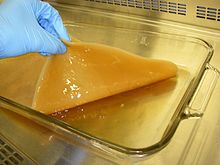**History and Discovery**:
– Cellulose discovered in 1838 by Anselme Payen.
– Industrial use in paper manufacture due to high reflectivity and low cost.
– Bacterial cellulose discovered by A.J. Brown in 1886.
– Detailed studies by C.A. Browne and Tarr and Hibbert in the 20th century.
**Production and Fermentation**:
– Multistep process involving UDPGIc synthesis and glucose polymerization.
– Various bacterial strains producing cellulose with different carbon sources.
– Factors affecting cellulose production include growth medium and byproducts.
– Glucose and sucrose commonly used, with ethanol sometimes added.
– Addition of organic acids and vitamins beneficial for yield.
**Properties and Applications**:
– Bacterial cellulose properties: high purity, strength, moldability, and water holding ability.
– Used in textiles, cosmetics, food products, and medical applications.
– Commercial uses in various industries.
– Diverse applications in food, medical, commercial, and industrial sectors.
– Versatile material for shaping into various products.
**Commercial Uses and Medical Applications**:
– Widening commercial applications in textiles, cosmetics, and food.
– Medical applications as wound dressings, tissue engineering, and surgical implants.
– Potential for artificial blood vessels and hybrid nanofibers.
– Used in hi-fi speakers, headphones, and papermaking.
– Enhancing properties of gauze dressings and aiding tissue regeneration.
**Research and Future Applications**:
– Research on scaling up microbial cellulose production for commercial use.
– Potential applications in electronic devices like e-book tablets and OLEDs.
– Application of conductive dopants and electrochromic dyes for image formation.
– Studies on biosynthesis mechanisms and culture conditions optimization.
– Possibility of microbial cellulose in dynamic wallpapers, rewritable maps, and learning tools.
Bacterial cellulose is an organic compound with the formula (C
6H
10O
5)
n produced by certain types of bacteria. While cellulose is a basic structural material of most plants, it is also produced by bacteria, principally of the genera Komagataeibacter, Acetobacter, Sarcina ventriculi and Agrobacterium. Bacterial, or microbial, cellulose has different properties from plant cellulose and is characterized by high purity, strength, moldability and increased water holding ability. In natural habitats, the majority of bacteria synthesize extracellular polysaccharides, such as cellulose, which form protective envelopes around the cells. While bacterial cellulose is produced in nature, many methods are currently being investigated to enhance cellulose growth from cultures in laboratories as a large-scale process. By controlling synthesis methods, the resulting microbial cellulose can be tailored to have specific desirable properties. For example, attention has been given to the bacteria Komagataeibacter xylinus due to its cellulose's unique mechanical properties and applications to biotechnology, microbiology, and materials science.


Historically, bacterial cellulose has been limited to the manufacture of the jelly-like desserts nata de piña and nata de coco, a Filipino food product. With advances in the ability to synthesize and characterize bacterial cellulose, the material is being used for a wide variety of commercial applications including textiles, cosmetics, and food products, as well as medical applications. Many patents have been issued in microbial cellulose applications and several active areas of research are attempting to better characterize microbial cellulose and utilize it in new areas.
